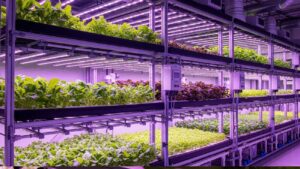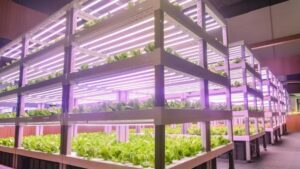BriteSwitch: Rebates Bloom as Horticulture Lighting Market Heats Up
 Once limited to research labs and specialized grow rooms, horticulture lighting has become one of the fastest-growing segments in the lighting industry. As technology costs drop and efficiency improves, these systems are now used in greenhouses, vertical farms, floriculture, and even in facilities producing plant-based vaccines. The global market is expanding at roughly 12% per year and is projected to reach $22 billion by 2033, making it one of the brightest opportunities for both lighting manufacturers and rebate-driven projects. Like they did with traditional lighting, LEDs have revolutionized grow lights. With 20 to 45% less energy usage than conventional HID grow lights, they provide a huge opportunity to cut operating costs for growers. The reduced wattage also means less waste heat, which is hugely beneficial to indoor growing operations. In October 2019, the DesignLights Consortium (DLC) created a new standard and Qualified Products List (QPL) specifically for horticulture lighting. Over the years, the DLC has become the de facto standard utilities use to ensure customers install high-quality lighting when applying for incentives. In 2025, the DLC released version 4.0 of its technical requirements. 55% of the US is covered by an active horticulture lighting rebate; 53% are calculated on a per-fixture basis. BriteSwitch Can Help You Find and Capture the Rebates:
Once limited to research labs and specialized grow rooms, horticulture lighting has become one of the fastest-growing segments in the lighting industry. As technology costs drop and efficiency improves, these systems are now used in greenhouses, vertical farms, floriculture, and even in facilities producing plant-based vaccines. The global market is expanding at roughly 12% per year and is projected to reach $22 billion by 2033, making it one of the brightest opportunities for both lighting manufacturers and rebate-driven projects. Like they did with traditional lighting, LEDs have revolutionized grow lights. With 20 to 45% less energy usage than conventional HID grow lights, they provide a huge opportunity to cut operating costs for growers. The reduced wattage also means less waste heat, which is hugely beneficial to indoor growing operations. In October 2019, the DesignLights Consortium (DLC) created a new standard and Qualified Products List (QPL) specifically for horticulture lighting. Over the years, the DLC has become the de facto standard utilities use to ensure customers install high-quality lighting when applying for incentives. In 2025, the DLC released version 4.0 of its technical requirements. 55% of the US is covered by an active horticulture lighting rebate; 53% are calculated on a per-fixture basis. BriteSwitch Can Help You Find and Capture the Rebates:
- RebatePro to Find Horticulture Rebates https://briteswitch.com/rebatepro-for-lighting.php
- Outsourcing Rebate Processing https://briteswitch.com/news/OutsourcingRebates.php



 Valued at $7.8 billion last year, the global controlled environment agriculture (CEA) market is expanding at a compound annual growth rate of 12.2% and expected to reach $22 billion by 2033, according to a recent market research
Valued at $7.8 billion last year, the global controlled environment agriculture (CEA) market is expanding at a compound annual growth rate of 12.2% and expected to reach $22 billion by 2033, according to a recent market research  Sollum Technologies is pleased to expand its lighting family, which now features three new fixtures: the SF-ONE™, the SF-PRO™ and the SF-MAX™. Designed to accommodate various lighting strategies, these new LED fixtures will meet the diverse needs of a rapidly growing clientele, from large scale to niche producers. All products come bundled with the SUN as a Service® cloud-based platform as well as access to Sollum’s smart support so that clients can reap all the benefits of a fully dynamic lighting solution. Each fixture responds to growers’ business priorities:
Sollum Technologies is pleased to expand its lighting family, which now features three new fixtures: the SF-ONE™, the SF-PRO™ and the SF-MAX™. Designed to accommodate various lighting strategies, these new LED fixtures will meet the diverse needs of a rapidly growing clientele, from large scale to niche producers. All products come bundled with the SUN as a Service® cloud-based platform as well as access to Sollum’s smart support so that clients can reap all the benefits of a fully dynamic lighting solution. Each fixture responds to growers’ business priorities: The DesignLights Consortium (DLC) has released their Draft 1 Horticultural Technical Requirements V4.0. The draft proposes three updates:
The DesignLights Consortium (DLC) has released their Draft 1 Horticultural Technical Requirements V4.0. The draft proposes three updates: